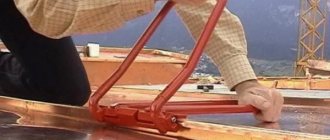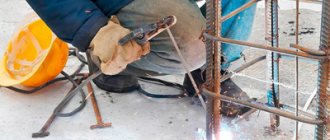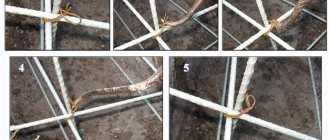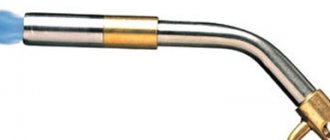Reinforcement frame indicating the locations of the strapping In all modern foundations, construction is not complete without the use of reinforcement - interconnected metal rods that absorb tensile stresses when used in conjunction with concrete. The frame creates vertical and horizontal belts, serves to increase the strength of the structure and uniformly distribute loads.
If the reinforcement is weakly or incorrectly connected, it will creep apart, thereby compromising the integrity of the foundation. This will lead to its slow destruction. Tying the rods together is quite simple, but highly specialized specialists know well how to properly knit reinforcement for the foundation. The frame connection scheme is almost the same for all types of foundations, except for columnar wooden or metal ones, where a frame is formed on top of the pile head using reinforcement or beams. They are connected to the head and welded, in which case the rods or wire rod have to be bent at a specific angle.
Why tying reinforcement with plastic clamps is considered unreliable
Connecting reinforcement at intersection points is a responsible event that is regulated by SNiP - building codes and regulations. Professional builders approach this issue straightforwardly - there are rules - we follow them.
SNiP says that it is necessary to connect the intersection points of the reinforcement during the manufacture of gratings with tying wire. In the classifier of professions there is a definition of “knitter”.
When tying reinforcement, a specialist of this profile must follow a number of rules that will allow him to create a spatial lattice of a reinforced concrete product or assembly, according to the parameters specified by the designer.
Plastic clamps are available in various sizes and characteristics, the key ones of which are:
- chemical quality of the material (nylon, polyamide);
- screed resistance to ultraviolet radiation;
- temperature range of application;
- withstand loads.
Since the appearance of clamps on the construction market, people's ingenuity has been trying, regardless of the cost of the experiment, to use plastic ties when tying reinforcement. It would seem clean, fast, neat, durable, even beautiful.
However, decades of active use of screeds in construction have not yet made it possible to include them in the list of materials approved for the manufacture of critical reinforced concrete structures.
That is, despite numerous practical experiments by private developers, in supervised construction, when specific performers will bear legal responsibility for the consequences, connecting reinforcement with plastic clamps is considered unreliable.
Reasons why plastic ties are not approved for use as connecting elements of reinforcing mesh:
- The linear temperature coefficient of expansion of plastic differs significantly from the values of this parameter for concrete, steel, and fiberglass composite reinforcement (nylon - six times, polyamide - seven times). When the finished foundation, floor slab, or reinforced concrete product freezes and heats up, numerous compression and expansion of the elements at the point of connection of the reinforcement over time, the places connected by a plastic clamp will be surrounded by microcracks. For critical work, the foundation and floor slabs are included; the use of rusty reinforcement is not allowed. The rules require a continuous concrete layer of at least 50 mm from the edge of the slab. Moisture absorbed by the surface layer of concrete cannot lead to corrosion of the reinforcement if the depth of “hiding” of the reinforcement is observed. Thermal compression and expansion of the screed that does not coincide with the total mass of the reinforced concrete products is the reason for their not being accepted by SNiPs.
- Knitting wire, regulated by thickness and number of layers, when knitting critical knots, and always means steel, with known characteristics. Plastic clamps have a wide range both in nomenclature (length, width, type of lock) and in the initial polymer material. It is impossible to achieve stable quality of the required characteristics from screeds from different manufacturers. Which, when using a large number of clamps (hundreds and thousands even on one object), will certainly lead to a difference in their characteristics, perhaps not noticeable externally. In this case, the plastic clamps may break even at the stage of concrete pouring, which will lead to unacceptable disruption of the spatial reinforcement grid.
- The construction industry is conservative in terms of regulation of building materials, primarily because its ultimate goal is the construction of facilities that will last for decades. And failure to comply with even small requirements, ultimately, after many years of operation, can lead to the destruction of the structure. It will be very interesting to conduct a control “opening” of the foundation or floor slab after 20-30 years, where the reinforcement was tied with plastic clamps. There is reason to believe that the corrosion of the reinforcement will be greater, and the “porosity” of the concrete will increase not only around the joint, but also spreading from it to the sides along the reinforcement.
- Working with plastic clamps in the cold leads to their breaking.
Tying reinforcement with plastic clamps is considered unreliable and unacceptable in professional construction, as it does not meet the requirements of SNiPs in terms of physical parameters, and has not stood the test of time.
Professionals reveal their cards: tying reinforcement with plastic clamps
Knitting the reinforcement cage is an important stage in the construction of the foundation. The strength and service life of the future structure depend on the correct choice of technology for forming the base and the correct choice of reinforcement. You should choose the optimal method for connecting plastic reinforcement. Since when using composite materials, a welded connection of the structure is an unacceptable option , other strapping options are used.
When using composite rods, you need to know how and with what to properly connect the frame elements.
There are several ways:
- with a crochet hook using traditional crochet wire;
- using knitting guns;
- plastic clamps;
- plastic clips.
Application area
The scope of application of reinforcing clamps is wide:
- civil and industrial monolithic construction;
- production of metal structures - fences, frames, cages, nets;
- reinforcement of brickwork;
- private construction - pouring foundations, installing concrete and stone fences, erecting walls of residential buildings.
An example of a reinforcement cage with clamps made of corrugated reinforcement, when reinforcing the grillage of a pile foundation.
Using a hook
For knitting, a special heat-treated wire with a diameter of 0.8 to 1.2 millimeters is used , which is quite plastic and does not lose its properties, even with repeated bending and twisting.
The rods are fixed with wire using a special crochet hook. There is also a screw hook, which allows you to mechanize the process and reduce the overall labor intensity.
But the use of this method is not rational for large-scale work, for example for a slab foundation.
Plastic clamps
This method does not require special skills or special equipment, unlike wire tying, and also does not take much time and provides good fixation of the elements. Another advantage worth noting is the minimization of the use of corrosive materials.
The negative aspects include:
- restriction of further actions when pouring the foundation, since walking on the reinforcement connected by clamps is strictly prohibited;
- no guarantee of maintaining the integrity of the connection during pouring.
However, it is possible to knit the reinforcement with plastic ties with a metal core , which add the benefits of wire knitting.
For strip foundation
Fiberglass is used to reinforce the strip foundations of individual small buildings.
The use of composite rods is explained by several reasons:
- minimizing corrosion;
- light weight of fiberglass;
- significant length of the rods, which allows you to get rid of joints on the horizontal load-bearing belt of the foundation, which are weak points when using metal reinforcement.
to completely get rid of the use of traditional metal reinforcement
when laying a strip foundation Quite heavy, since the composite rods are difficult to bend without cracking.
There are special devices for bending, but for a single construction its use will not be profitable. Therefore, metal reinforcement with a diameter corresponding to the selected thickness of fiberglass is used in the corners. Find out how to choose the right fittings here. When forming load-bearing belts from fiberglass, two diameters of rods are used: the longitudinal parts of the frame are assembled from the larger diameter reinforcement, and the vertical and transverse parts are assembled from the smaller ones.
An operation such as knitting a frame for a strip foundation is quite difficult to carry out alone, especially in the absence of experience. Performing this operation alone may have undesirable consequences. According to standards, reinforcement should be done by three people.
When using fiberglass reinforcement, you need to carefully approach the issue of connecting the rods. First of all, it is worth assessing the scale of the work - with a large volume of work, will it be advisable to manually tie the entire frame together? It is also worth considering some external factors, such as low temperatures, which preclude the use of clamps. The most universal way is to fix it with plastic clips.
Connection method by welding
At first glance, one of the fastest, simplest and best ways to fairly reliably and firmly connect reinforcing bars to each other is to weld them.
However, like any other simple method, it has several significant disadvantages. For example, the first disadvantage is a significant decrease in the quality of the reinforcement product, which leads to a deterioration in the strength of the entire building. The next drawback is the clear need to attract both additional resources and professionals in this field to this process. Scheme of strip foundation reinforcement.
Welding significantly increases the rigidity of the reinforcement frame several times, which is usually unreasonable. Reinforcing blocks are often damaged and broken, so their displacement is very dangerous, and when the building shrinks and the density of concrete increases, this happens quite often.
Given that during the construction process concrete vibrators are often used to compact the composition, the likelihood of failure of welding joints increases.
Considering all these reasons, the method of connecting reinforcement by welding is ineffective and is rarely used.
Is tying reinforcement with plastic clamps allowed?
IMHODom › Forums › foundations and floors › Is tying reinforcement with plastic clamps allowed?
- This topic has 10 replies, 10 voices, and was last updated 10 months ago by Zaets.
Is tying reinforcement with plastic clamps allowed?
SNiP says that connecting the intersection points of reinforcement during the manufacture of gratings must be done with tying wire. Was this written before the advent of plastic clamps or is it still true today?
- Stepanovka
If after the appearance of clamps no changes were made to SNiP, then that is not what they appeared for.
the whole question here is that these clamps don’t fly off when the concrete starts pouring











